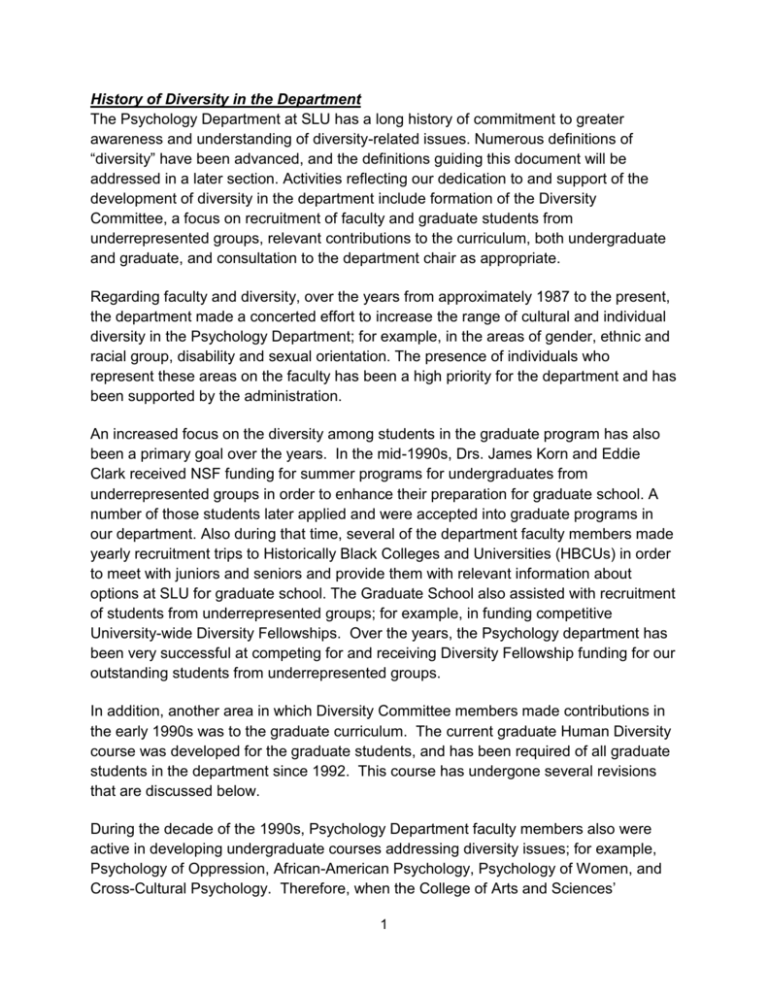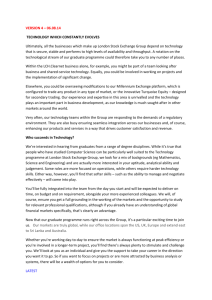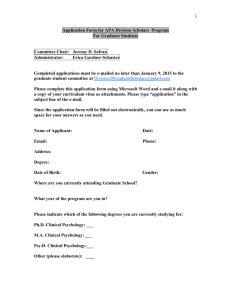History of Diversity in the De
advertisement

History of Diversity in the Department The Psychology Department at SLU has a long history of commitment to greater awareness and understanding of diversity-related issues. Numerous definitions of “diversity” have been advanced, and the definitions guiding this document will be addressed in a later section. Activities reflecting our dedication to and support of the development of diversity in the department include formation of the Diversity Committee, a focus on recruitment of faculty and graduate students from underrepresented groups, relevant contributions to the curriculum, both undergraduate and graduate, and consultation to the department chair as appropriate. Regarding faculty and diversity, over the years from approximately 1987 to the present, the department made a concerted effort to increase the range of cultural and individual diversity in the Psychology Department; for example, in the areas of gender, ethnic and racial group, disability and sexual orientation. The presence of individuals who represent these areas on the faculty has been a high priority for the department and has been supported by the administration. An increased focus on the diversity among students in the graduate program has also been a primary goal over the years. In the mid-1990s, Drs. James Korn and Eddie Clark received NSF funding for summer programs for undergraduates from underrepresented groups in order to enhance their preparation for graduate school. A number of those students later applied and were accepted into graduate programs in our department. Also during that time, several of the department faculty members made yearly recruitment trips to Historically Black Colleges and Universities (HBCUs) in order to meet with juniors and seniors and provide them with relevant information about options at SLU for graduate school. The Graduate School also assisted with recruitment of students from underrepresented groups; for example, in funding competitive University-wide Diversity Fellowships. Over the years, the Psychology department has been very successful at competing for and receiving Diversity Fellowship funding for our outstanding students from underrepresented groups. In addition, another area in which Diversity Committee members made contributions in the early 1990s was to the graduate curriculum. The current graduate Human Diversity course was developed for the graduate students, and has been required of all graduate students in the department since 1992. This course has undergone several revisions that are discussed below. During the decade of the 1990s, Psychology Department faculty members also were active in developing undergraduate courses addressing diversity issues; for example, Psychology of Oppression, African-American Psychology, Psychology of Women, and Cross-Cultural Psychology. Therefore, when the College of Arts and Sciences’ 1 Diversity requirement for graduation was instituted in Fall 1993, these courses made an important contribution. History of the Diversity Committee In Fall 1990, the chair of the department, Dr. James Korn, invited a group of faculty to form a department diversity committee. The charge was to address “human diversity across the curriculum”, conceptualized broadly. This group has been a standing committee since then, serving in an advisory capacity to department chairs as needed. Committee members (Eddie Clark, John Cross, Judy Gibbons, Aaronette White, and Honore Hughes) during that time period made the decision to work in two ways to increase diversity content in the curriculum: first, to teach specific graduate and undergraduate stand-alone courses, and second, to infuse diversity content into the curriculum generally. Over the years membership has been open to any psychology faculty member who has an interest in the issues addressed by the committee, although broad representation across programs and specialty areas has been sought. As mentioned above, one of the first tasks of the committee in Spring of 1991 was to develop a Human Diversity graduate course, in response to graduate students’ requests. In Fall 1992, department faculty voted to require the course of all graduate students entering the department, starting in 1993-1994. Initially this course was teamtaught by several faculty members, who also invited a number of guest speakers from within the department and university to discuss their diversity-related areas of expertise. This format remained the same through the decade. Due to changing priorities and needs in the department, in Spring 2002 the graduate Human Diversity course was revised by diversity committee members in consultation with the department’s graduate students and faculty. In Fall 2003, the new modular format (three sections: awareness, teaching and research, and professional practice), was implemented, and the course was taught by a single faculty member. (Example syllabi are available via the T-drive). As a way of continuing to infuse diversity content across the curriculum, in Spring 2010, the Committee initiated an annual Diversity Day and colloquium series. Typically, the colloquium has been presented in February, with speakers suggested by faculty and students. From the beginning, the goal has been to bring in speakers from a variety of backgrounds and perspectives who have a broad appeal across the department. In addition, the committee has functioned in an advisory capacity to the department. When requested, the Diversity Committee members have provided informal input to department chairs and faculty. For example, the committee offered formal consultation to the department chair regarding inflammatory religious literature that was placed in 2 various places in the department by an unknown person. Committee members also have informally advised faculty members and graduate students who have requested input on handling sensitive diversity-related issues in their classes. In March, 2014, the Diversity Committee changed the name of the committee to Diversity and Inclusion committee, to more accurately reflect the goals of the committee and the focus of committee members’ activities. 3






